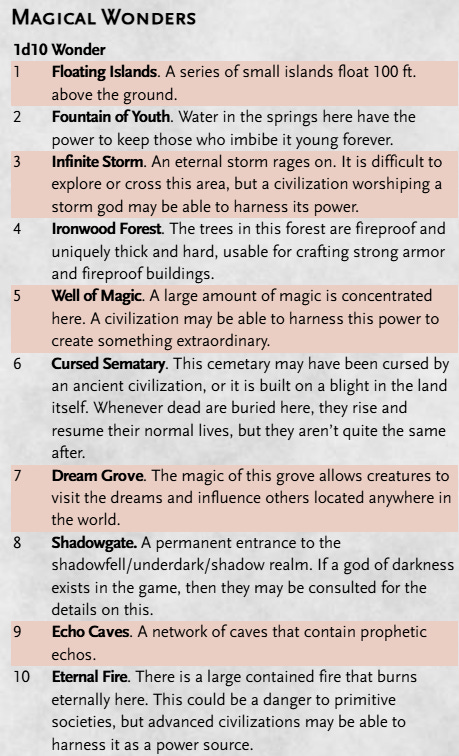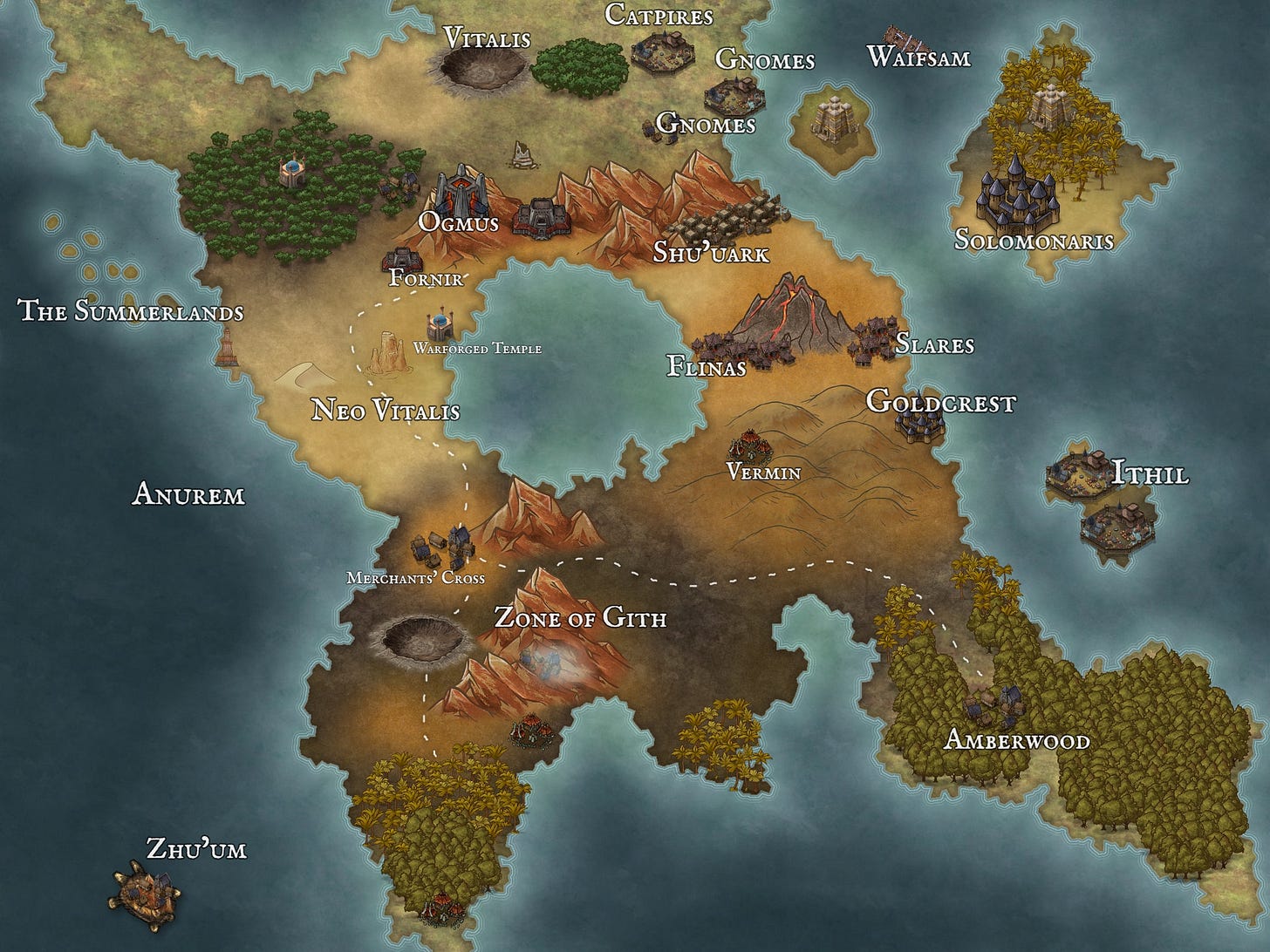This is the second in a series of blog posts about my Godstein game. I would recommend starting at the first, or don’t, I can’t tell you what to do.
I didn’t cover this in the first post, but this campaign is entirely online. I love in-person RPGs as much as the next person, but I moved away from my friend group about 5 years ago and I wanted to include them in this game, so it was going to have to be online. We used Discord for communications and Roll20 primarily to organize information and character sheets.
After a week of deliberation about their gods, each of my 6 players had an idea of what they wanted their god to be and how they were related. Most of them were in the same family aside from Kimaris (TN, time/war), who existed separately.
I set up a 50-mile hex overlay for the map in Roll20 and I made a d10 table of magical wonders and put 6 of them on random hexes, which were hidden from the players. These were inspired by the game Civilization but with more magic.
I wasn’t sure yet the purpose of this, but I knew I wanted to have magical elements in the world and these would hopefully drive some of the campaign after the initial world generation. I came up with most of these from researching and brainstorming. I even had players help add a few to the list before they were rolled. If I could do this again, I would have them grant mana to the god whose civilization found it. I will cover mana in the next post, but essentially it is the gods’ primary resource that they can spend to affect the world.
I gave them the structure of rounds, where they would all chat amongst each other, then give me orders for what they wanted to accomplish that round and after I received the orders, I would make appropriate changes to the map. Of course, they were allowed to lie to other players about their orders. We had a few chat channels set up in the discord so that they could break away and multiple groups could converse and coordinate as well as a private chat for each player and me to store notes related to their god. This chat would be used to track resources, keep notes, and adjudicate downtime activities.
In the first round, they all got to terraform 3 hexes, but no real civilizations would be built quite yet. If they came into conflict, they would simply negotiate, or if they could not negotiate, roll, with bonuses awarded based on various situations (relevant domain, favored terrain, etc.).
In the second round, I had them place the capital cities of their chosen people, which could be anywhere on the map- the dwarves and arachnae took the mountains, the humans, gnomes, and vampires settled in the north, and the tieflings were near the volcano. This left the entire south unsettled, which became an issue later when Kheper’Zall (NE, infernal/light) extended her tiefling empire south.
It was all very simple, but intrigue emerged almost immediately- Vita’Thios (NE, life/darkness) and Kimaris (TN, time/war) attempted to terraform the same land, and neither had communicated this well. Kimaris was pushed out towards an island and Vita’Thios occupied most of the far north.
Last post, I noted that gnomes were Kimaris’ chosen people, but this wasn’t entirely correct. Kimaris originally chose a race of sphinx as his chosen people, but he and Vita’Thios immediately tried to place their capital city on the same hex, and they could not come to an agreement, so they rolled, despite Kimaris having a bonus to his roll for the war domain, Vita’Thios won this roll by a lot and declared that his people turned the sphinxes into undead thrall. This meant that Kimaris had to recreate his chosen people in the next round, and that is when the gnomes were created.
After the first few rounds, they were allowed to give 3 orders per round. Orders could be to terraform, attack another city, establish a settlement, defend a settlement, explore 3 tiles (find a hidden wonder if there), do something specific to their god, or there were a few other options I gave them. I also left it open for them to be creative here.
The most dramatic and interesting throughline in this portion of the campaign involved the humans, who attempted to build a tower to the heavens, were smote, and their city drug down to the underground by Vita’Thios (NE, life/darkness). Mortir (LG, death/commerce) was able to shepherd the survivors south away from their fallen city and founded a city in the desert. At the end of this portion of the campaign, which took about 8 hours, we had a working map. Most of the place names on this map were placeholders as we didn’t name all the locations as they developed, but they would all be named eventually.
There was some conflict, but less than I hoped for in this phase. Ognir, the god of the dwarves, basically turtled for the entire world generation phase and interacted with others as little as possible. I wouldn’t say this was a problem with the player, but more a symptom of inadequate incentives for conflict. The magical wonders that I placed were an attempt to remedy this and encourage conflict, but I failed to utilize this mechanic to the fullest because almost all of the randomly rolled locations ended up being on the edge of the map and far away from where most of the players settled. They all ended up being found, but they were all found by one player who was exploring the edge of the map alone, the player built a settlement there, and then no one ever challenged it because it was off in a secluded corner. I should have intentionally placed a few near the center. Granted, I did not know where people would place their settlements when I randomized them, but the wonders should have been placed intentionally in areas that would have provoked conflict.
Another aspect that I wish I had used more during this phase of the game is the artifacts that I had players describe when they were making their gods. I assumed at the start, that every god and civilization would possess their artifact, but I wish I had rolled for that instead, either at the beginning or after maybe round 3 or so. The table may look like this:
This would have provided some of the gods with a clearer goal and could have stirred up more conflict as well as provided an incentive to explore more hexes. Of course, there would need to be a reward for a player ending the world generation phase in possession of their artifact, which would probably be going into the campaign with more resources, which I will explain in the next post.
Other than failing to provoke enough conflict in the first session of the game, the world-building portion of the game was a success. It lasted about 8 hours total over 2 sessions with a hefty back and forth throughout the week and we came out of it with a workable setting with some conflict and a civilization that was sort of controlled by each player. The players would be allowed to GM parts of this campaign as the groups traveled into their territory and players could run travel encounters on the road that pertained to their god. It was an odd setup and there was some genre mixing- it wasn’t exactly a setting I might have come up with myself, but this didn’t matter. The most important thing is the player investment.





Artifacts (to start fires that blaze into holy wars) ought to be entrusted to the mere mortals that fuel the god's mana. Favored races have racial traits to attribute to their creators, but artifacts give gods a means to sway swathes of other races away from their rivals. After all, sharing is caring, and anti-trust laws are so hard to enforce in matters of faith. Whoever holds each artifact holds great power, and fuels the mana reserves of the creator. The god cannot destroy each other's artifacts, but can inspire their own followers to capture, mock, and hide the artifacts of rivals.
Not trying to be critical, but sounding out my own inspirations to build on the shoulders of Giants.
When you say humans attempted to build a tower to the heavens and were smote, how did that come about? Player God intervention?